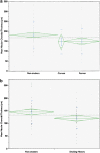Smoking and choroidal thickness in patients over 65 with early-atrophic age-related macular degeneration and normals
- PMID: 24833184
- PMCID: PMC4094797
- DOI: 10.1038/eye.2014.100
Smoking and choroidal thickness in patients over 65 with early-atrophic age-related macular degeneration and normals
Abstract
Objective: To compare macular choroidal thickness between cigarette smokers, those with a history of smoking, and nonsmokers in patients over 65 years of age with early-atrophic age-related macular degeneration (AMD) and normals.
Methods: Prospective, consecutive, observational case series. Enhanced depth imaging spectral domain optical coherence tomography 12-line radial scans were performed and choroidal thickness manually quantified at 84 points in the central 3 mm of the macula. Data of normals, soft drusen alone, and soft drusen with additional features of early AMD were compared. A multivariate analysis of variance (MANOVA) model, controlling for age, was constructed to evaluate the effect of smoking history and AMD features on choroidal thickness.
Results: A history of smoking was significantly associated with a thinner choroid across all patients via logistic regression (P=0.004; O.R.=12.4). Mean macular choroidal thickness was thinner for smokers (148±63 μm) than for nonsmokers (181±65 μm) among all diagnosis categories (P=0.003). Subgroup analysis of patients with AMD features revealed a similar decreased choroidal thickness in smokers (121±41 μm) compared with nonsmokers (146±46 μm, P=0.006). Bivariate analysis revealed an association between increased pack-years of smoking and a thin choroid across all patients (P<0.001) and among patients with features of early AMD (P<0.001). Both the presence of features of macular degeneration (P<0.001) and a history of smoking (P=0.024) were associated with decreased choroidal thickness in a MANOVA model.
Conclusion: Chronic cigarette smoke exposure may be associated with decreased choroidal thickness. There may be an anatomic sequelae to chronic tobacco smoke exposure that underlies previously reported AMD risk.
Figures



Similar articles
-
Comparison of macular choroidal thickness among patients older than age 65 with early atrophic age-related macular degeneration and normals.Invest Ophthalmol Vis Sci. 2013 Sep 19;54(9):6307-13. doi: 10.1167/iovs.13-12653. Invest Ophthalmol Vis Sci. 2013. PMID: 23982844
-
Analysis of choroidal thickness in age-related macular degeneration using spectral-domain optical coherence tomography.Am J Ophthalmol. 2011 Oct;152(4):663-8. doi: 10.1016/j.ajo.2011.03.008. Epub 2011 Jun 25. Am J Ophthalmol. 2011. PMID: 21708378 Free PMC article.
-
Macular choroidal thickness and volume of eyes with reticular pseudodrusen using swept-source optical coherence tomography.Am J Ophthalmol. 2014 May;157(5):994-1004. doi: 10.1016/j.ajo.2014.01.018. Epub 2014 Jan 31. Am J Ophthalmol. 2014. PMID: 24491418
-
Morphologic features of large choroidal vessel layer: age-related macular degeneration, polypoidal choroidal vasculopathy, and central serous chorioretinopathy.Graefes Arch Clin Exp Ophthalmol. 2018 Dec;256(12):2309-2317. doi: 10.1007/s00417-018-4143-1. Epub 2018 Sep 27. Graefes Arch Clin Exp Ophthalmol. 2018. PMID: 30259090 Review.
-
Enhanced depth imaging optical coherence tomography in age-related macular degeneration.Semin Ophthalmol. 2012 Sep-Nov;27(5-6):209-12. doi: 10.3109/08820538.2012.708807. Semin Ophthalmol. 2012. PMID: 23163278 Review.
Cited by
-
Evaluation of Peripapillary and Subfoveal Choroid Thickness in Asymptomatic Carotid Artery Stenosis.Clin Ophthalmol. 2020 Jun 17;14:1641-1650. doi: 10.2147/OPTH.S237403. eCollection 2020. Clin Ophthalmol. 2020. PMID: 32606579 Free PMC article.
-
Cross-sectional study of smoking exposure: no differential effect on OCT metrics in a cohort of MS patients.Mult Scler J Exp Transl Clin. 2019 Feb 25;5(1):2055217319828400. doi: 10.1177/2055217319828400. eCollection 2019 Jan-Mar. Mult Scler J Exp Transl Clin. 2019. PMID: 30828461 Free PMC article.
-
Unveiling the Impact of Electronic Cigarettes (EC) on Health: An Evidence-Based Review of EC as an Alternative to Combustible Cigarettes.Cureus. 2024 Mar 19;16(3):e56451. doi: 10.7759/cureus.56451. eCollection 2024 Mar. Cureus. 2024. PMID: 38638766 Free PMC article. Review.
-
[Atrophy of the macula in the context of its wet, age-related degeneration : An inescapable consequence of anti-VEGF therapy?].Ophthalmologe. 2016 Dec;113(12):1036-1045. doi: 10.1007/s00347-016-0306-9. Ophthalmologe. 2016. PMID: 27364637 Review. German.
-
The Application of Enhanced Depth Imaging Spectral-Domain Optical Coherence Tomography in Macular Diseases.J Ophthalmol. 2020 Aug 24;2020:9503795. doi: 10.1155/2020/9503795. eCollection 2020. J Ophthalmol. 2020. PMID: 32908688 Free PMC article. Review.
References
-
- SanGiovanni JP, Chew EY, Clemons TE, Ferris FL, 3rd, Gensler G, Lindblad AS, et al. The relationship of dietary carotenoid and vitamin A, E, and C intake with age-related macular degeneration in a case-control study: AREDS Report No. 22. Arch Ophthalmol. 2007;125 (9:1225–1232. - PubMed
-
- Khan JC, Thurlby DA, Shahid H, Clayton DG, Yates JR, Bradley M, et al. Smoking and age related macular degeneration: the number of pack years of cigarette smoking is a major determinant of risk for both geographic atrophy and choroidal neovascularisation. Br J Ophthalmol. 2006;90 (1:75–80. - PMC - PubMed
Publication types
MeSH terms
LinkOut - more resources
Full Text Sources
Other Literature Sources
Molecular Biology Databases

